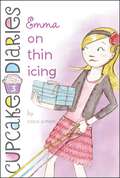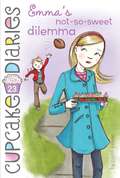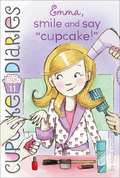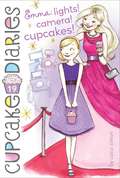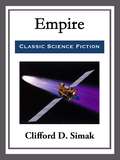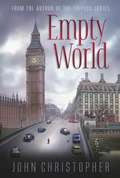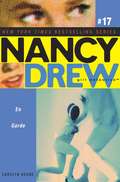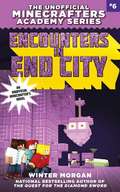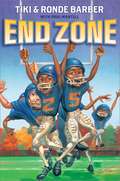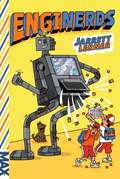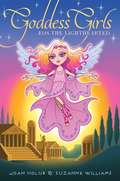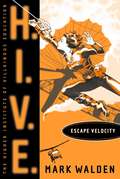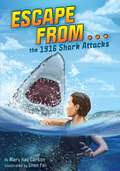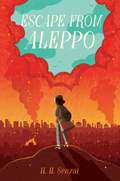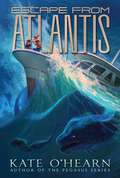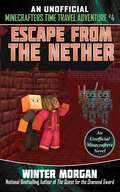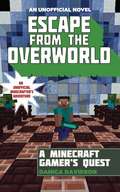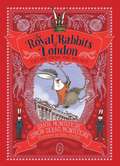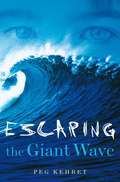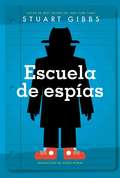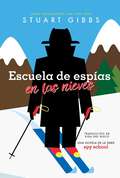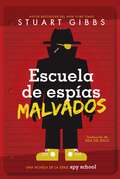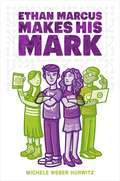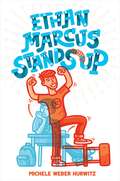- Table View
- List View
Emma on Thin Icing
by Coco SimonWhen Mia asks the girls in the club to be junior bridesmaids in her mother's wedding, everyone is superexcited about the idea...especially when they find the perfect dress for the occasion! It's Emma's dream dress, except it's a little more than she expected. And with her mom now out of a job (she's been put on furlough at the library) there's not a lot of room at the Taylor's house for extras. But not wanting to disappoint her friends, Emma decides to take on a few more jobs and chores around the house to help cover the cost. Between babysitting her bratty brother, a dog-walking business, flute practice, the Cupcake Club--and oh yeah, being a typical tween girl--Emma may have bitten off more than she can chew. Can she handle it all?
Emma's Not-So-Sweet Dilemma
by Coco SimonEmma loses an important modeling job due to an injury she got while playing with her brothers. How will she pay for the beautiful holiday presents she planned for her family and friends?Emma is playing ball with her brothers on an unusually warm winter afternoon. But an errant toss from her brother Matt hits her right on the nose! Luckily, it's nothing more serious than a little swelling, but it's enough to make her lose an important modeling job at The Special Day salon. Mona hires "mean girl" Olivia Allen to fill in. Olivia is thrilled, not only for the job, but also for a chance to spread some nasty rumors about Emma. Worst of all, now Emma can't afford the beautiful holiday gifts she planned to buy her family and friends. Emma's Cupcake Club pals remind her that the best gifts come from the heart, and don't have a price tag.
Emma, Smile and Say "Cupcake!"
by Coco SimonEmma wants to be a model, but membership in the Cupcake Club might be all the fame she needs.The Special Day wedding salon is running an ad in the local newspaper, and they want Emma to model in the advertisement. When a local department store also wants to use Emma as a model, she's suddenly very much in demand! But after running all over New York City for auditions (and being told over and over she "just isn't right") Emma realizes being a model is a lot tougher than she thought. Does Emma really want to be America's next top model, or is being a part of the Cupcake Club sweet enough?
Emma, Smile and Say "Cupcake!"
by Coco SimonEmma wants to be a model, but membership in the Cupcake Club might be all the fame she needs.The Special Day wedding salon is running an ad in the local newspaper, and they want Emma to model in the advertisement. When a local department store also wants to use Emma as a model, she's suddenly very much in demand! But after running all over New York City for auditions (and being told over and over she "just isn't right") Emma realizes being a model is a lot tougher than she thought. Does Emma really want to be America's next top model, or is being a part of the Cupcake Club sweet enough?
Emma: Lights! Camera! Cupcakes!
by Coco SimonEmma has a supersweet, superstar secret--but can she keep it from the Cupcake Club?Hollywood star Romaine Ford is back in town, and she needs cupcakes for her movie premiere...and her wedding! But everything is top-secret. Emma is asked to make the cupcakes, but she can't tell the rest of the club who they are for! Romaine doesn't want any paparazzi to ruin her wedding, and she feels the less people who know, the better. Can Emma fulfill this order without spilling the secret to her best friends?
Empire
by Clifford D. SimakMankind is united under the rule of a single corporation and has begun to explore and settle the stars. The corporation maintains its control over mankind by having a monopoly on energy. But that's about to change and the corporation will do anything to hold onto its power, even plunge all of mankind into war. Powerful and poignant.
Empty World
by John ChristopherWhen Neil survives a deadly plague and plunges into solitude, he must question everything in this gripping adventure from critically acclaimed Tripods author John Christopher.Neil's world is shattered when he and his family are involved in a horrible car accident that leaves him an orphan. He is sent to live in a small village with his grandparents, whom he loves but doesn't really know.Soon, a devastating illness, the Calcutta Plague, begins making the headlines. After killing thousands of people in India in just a few months, the disease begins to spread much farther, quickly sweeping across the world and eventually settling in the same village where Neil resides. The sickness is a strange one, affecting only the adults and none of the children, and soon Neil finds himself an orphan once more.Alone, Neil travels to London in search of other survivors of the plague. There he finds a strange world of fear and suspicion, where friends can be enemies and people will do anything to survive. In this time of strife, amid the excitement and loneliness of his solitude, can Neil find a way to focus on what matters most?
En Garde
by Carolyn KeeneNancy's heading to London to crack the case in this New York Times bestselling series!George gets into fencing in a big way, which means lots of cool matches for Nancy and Bess to watch. But when an inexplicably deadly rivalry between two of the strongest fencers rears its ugly head, Nancy gets of the bleachers and starts sleuthing. Can she figure out what the rivalry's all about before someone gets fenced in?
Encounters in End City: The Unofficial Minecrafters Academy Series, Book Six (Unofficial Minecrafters Academy #6)
by Winter MorganIt’s graduation week at Minecrafters Academy, but a battle is brewing between the top five students at the school. With the school’s top five students wrapped up in an endless prank war as they compete over the coveted position of class speaker, one of their classmates finds a solution: the students will travel to an End city and hunt for treasure; the student who not only survives, but returns with the most treasures, will be chosen. The students set off on their journey, but they quickly learn that the End is no joke. Face-to-face with shulkers, the deadly Void, and the mighty Ender Dragon, the school’s top students learn there’s more to success than making the grade. They must learn to fight together—or no one will make it back alive.In this final installment of the Unofficial Minecrafters Academy series, the risks—and the potential rewards—are greater than ever.
End Zone
by Paul Mantell Tiki Barber Ronde BarberThe Hidden Valley Eagles have high hopes for the football championship in this novel from NFL superstars and bestselling authors Tiki and Ronde Barber.Tiki and Ronde are ready to end junior high with a win--a big win! Their dream is to see their team in the championship, and with the Hidden Valley Eagles' undefeated season, their chances are strong. But when Manny, the star quarterback, starts having headaches, the doctor says he has a minor concussion, and he is out for two weeks. The whole school is counting on the team, but with pressure building, Tiki and Ronde are starting to lose their confidence. More than that, they think their good luck is going to run out. Will the team let an injury keep them from the championship? Or can they learn to work together to bring home a win? From real-life NFL superstar brothers Tiki and Ronde Barber, this is an inspiring story of teamwork and triumph.
EngiNerds
by Jarrett LernerThe battle between boys and bots is on in this funny, fast-paced novel.Ken is an EngiNerd: one of a super-smart group of friends—all nerds—who have been close since kindergarten. They may be brainiacs, but they’re just like everyone else: they fight with one another, watch too much TV, eat Chinese food, and hate walking their dogs. Well, maybe not just like everyone because Ken’s best friend Dan has been building robots. He then secretly sent one to each of the EngiNerds, never letting them know he’s the mastermind. At first Ken is awed and delighted: what kid hasn’t dreamed of having a robot all their own? Someone who can be their friend, clean their room, walk the dog, answer homework questions…how amazing is that? But be careful what you wish for: Dan’s robot, Greeeg, may look innocent, but his ravenous consumption of food—comestibles—turns him into a butt-blasting bot. And once the other robots ‘come alive’ it’s up to the motley crew of EngiNerds to not only save the day, but save the planet!
Eos the Lighthearted (Goddess Girls #24)
by Joan Holub Suzanne WilliamsGet to know Eos, the Goddess of Dawn, in this twenty-fourth Goddess Girls adventure!
Escape Velocity (H.I.V.E. #3)
by Mark WaldenNow in paperback, a riveting installment in an action-packed series.Students and staff at H.I.V.E.—the Higher Institute of Villainous Education—are horrified to discover that Dr. Nero has been captured by the forces of H.O.P.E.—the Hostile Operative Prosecution Executive—the world’s newest and most ruthlessly efficient security force. Otto decides that the only way to find Nero and the truth behind the lies is to escape H.I.V.E. But he’s also struggling with some newfound abilities: Can he really unconsciously interface with computers without physical contact? And if he can, what exactly do his new powers mean? In his search for answers, Otto must flee H.I.V.E., and take the risks that come with being a rogue agent. Then he just has to break into MI6…..
Escape from . . . the 1916 Shark Attacks (Escape From . . .)
by Mary Kay CarsonStay out of the water! During the summer of 1916, the "Jersey man-eater"-a great white shark-terrorized the coast of New Jersey. Based on real events, new friends Ed and Mike have to work together to survive one of the deadliest shark attacks in history!In the blistering summer of 1916, Ed Mitchell is melting in the heat wave boiling New York City. All the city pools are closed because of the polio epidemic, so Ed can't wait to flee to the Jersey Shore and cool off in the ocean. But during his first dip, a great white shark attacks a swimmer and sends the coastline into a panic. Ed is sent away from the shore to visit his aunt in Matawan, New Jersey, where he can stay safe and cool.In Matawan, Ed meets Mike Anders-a local boy who knows all the best spots in the nearby creek. Mike vows to teach Ed to swim, and Ed promises to help Mike read better. Little do they know, the new friends are about to have the summer of their lives.The "Jersey man-eater," the dangerous shark who keeps attacking swimmers, is headed right up the coast and into their favorite swimming spot! Will Ed and Mike be able to survive one of the deadliest shark attacks in history?
Escape from Aleppo
by N. H. SenzaiAn Indie Next List Pick <p><p> Nadia’s family is forced to flee their home in Aleppo, Syria, when the Arab Spring sparks a civil war in this timely coming-of-age novel from award-winning author N.H. Senzai.Silver and gold balloons. <p><i>A birthday cake covered in pink roses. A new dress. </i> <p>Nadia stands at the center of attention in her parents’ elegant dining room. This is the best day of my life, she thinks. Everyone is about to sing “Happy Birthday,” when her uncle calls from the living room, “Baba, brothers, you need to see this.” Reluctantly, she follows her family into the other room. On TV, a reporter stands near an overturned vegetable cart on a dusty street. Beside it is a mound of smoldering ashes. The reporter explains that a vegetable vendor in the city of Tunis burned himself alive, protesting corrupt government officials who have been harassing his business. Nadia frowns. <p> It is December 17, 2010: Nadia’s twelfth birthday and the beginning of the Arab Spring. Soon anti-government protests erupt across the Middle East and, one by one, countries are thrown into turmoil. As civil war flares in Syria and bombs fall across Nadia’s home city of Aleppo, her family decides to flee to safety. Inspired by current events, this novel sheds light on the complicated situation in Syria that has led to an international refugee crisis, and tells the story of one girl’s journey to safety.
Escape from Atlantis (Atlantis #1)
by Kate O'HearnFrom the author of the Pegasus series comes a spellbinding first book in a new fantasy series for fans of Rick Riordan and Shannon Messenger following two cousins whose summer vacation gets swept away by a storm that lands them on the lost island of Atlantis.The last way that Riley Evans wanted to spend spring break was studying whales on the family sailboat in the middle of the Bermuda Triangle. With only her dad, aunt, and annoying cousin Alfie for company, she is so bored staring at the waves that she&’s starting to see mermaids between them. But when their boat is capsized during a sudden storm, Riley finds more excitement than she bargained for as she and Alfie are washed ashore with neither of their parents in sight. Where they&’ve been shipwrecked is no deserted island, though. Atlantis is a place beyond imagination, inhabited by both people and incredible creatures ranging from unicorns and gargoyles to talking animals. But not everyone welcomes the cousins&’ arrival, and beneath the wonder of this mythical land lurk dangerous secrets—something strange is happening to the inhabitants. What Riley wants more than anything is to find her father and go home. But the closer she gets to this goal, the more the islanders seem determined to keep her from reaching it. As Riley and Alfie unravel the mystery of Atlantis and its most terrifying part, the Forbidden Zone, they realize that the clock is ticking. If they can&’t learn what happened to their parents and find a way off the island soon, it may be too late to leave.
Escape from the Nether: An Unofficial Minecrafters Time Travel Adventure, Book 4 (An Unofficial Minecrafters Time Travel A #1)
by Winter MorganBrett and his friends are running low on ingredients to craft potions and take a trip to the Nether. While gathering Nether Wart and Soul Sand from a fortress, they hear a noise in a room. They enter the room and see a hole in the wall and hear cries coming from the other side. They crawl through the hole to help the unknown person, but wind up in another time period in the Nether. They have to help someone from the future get home. Using their skills from future time travel adventures, they must help this stranger get home. Will they survive the Nether? Will they get this person home? And should they trust this person who tells them stories about what the world will be like a hundred years in the future?
Escape from the Overworld: An Unofficial Overworld Adventure, Book One (Unofficial Overworld Adventure #1)
by Danica DavidsonEleven-year-old Stevie, who comes from a long line of Steves, doesn't feel as if he fits in the Minecraft world. His father is great at building and fighting off zombies, but Stevie struggles in these areas. One day, when Stevie is alone in the field trying to build something new that will impress his dad, he discovers a portal into a new world.Stevie steps out of a computer screen and into the room of eleven-year-old Maison, a sixth-grade girl who loves to build and create, but who is bullied and made an outcast by her classmates for not indulging in activities deemed "cool." Stevie is shocked by how different this world is, and Maison takes him under her wing and teaches him all about her world. The two become friends, and Maison brings Stevie to school with her.Stevie is horrified to see there are zombies in the school! He realizes that when he opened the portal, this allowed zombies to also enter the new world. More and more creatures are slipping out by the second, wreaking havoc on a world that has no idea how to handle zombies, creepers, giant spiders, and the like. Stevie and Maison must put their heads together and use their combined talents in order to push the zombies back into Minecraft, where they belong. As Stevie and Maison's worlds become more combined, their adventure becomes even more frightening than they could have imagined.
Escape from the Palace (The Royal Rabbits of London #2)
by Simon Sebag Montefiore Santa Montefiore Kate HindleyMission Impossible and James Bond have nothing on this wily bunch of rabbits who are pledged to protect the Queen of England—and the President of the United States—from a dastardly plot in this charming second novel of the Royal Rabbits of London series.Life is an adventure. Anything in the world is possible—by will and by luck, with a moist carrot, a wet nose and a slice of mad courage! Little Shylo Tawny-Tail is proud to call himself one of the Royal Rabbits of London, a secret order who live under Buckingham Palace and fight evil across the world. But high up in London’s famous skyscraper, the Shard, the horrible ratzis are plotting to cause chaos during a visit from the President of the United States. And when the Grand Burrow is attacked and Shylo is kidnapped, it looks as though they might just manage it! Can Shylo escape in time to save the day?
Escaping the Giant Wave
by Peg KehretThe Worst Vacation Ever! Thirteen-year-old Kyle thought spending a vacation on the Oregon coast with his family would be great. He'd never flown before, and he'd never seen the Pacific Ocean. One evening Kyle is left in charge of his younger sister, BeeBee, while his parents attend an adults-only Salesman of the Year dinner on an elegant yacht. Then the earthquake comes -- starting a fire in their hotel! As Kyle and BeeBee fight their way out through smoke and flame, Kyle remembers the sign at the beach that said after an earthquake everyone should go uphill and inland, as far from the ocean as possible. Giant tsunami waves -- three or four stories high can ride in from the sea and engulf anyone who doesn't escape fast enough. Kyle and BeeBee flee uphill as a tsunami crashes over the beach, the hotel, and the town. The giant wave charges straight up the hillside and through the woods where the children are running for their lives. The perfect vacation has become a nightmare! Somehow Kyle and BeeBee have to outwit nature's fury and save themselves from tsunami terror.
Escuela de espías (Spy School)
by Stuart GibbsNow available in Spanish! ¿Podrá un inexperto agente encubierto convertirse en un súper espía? Ben Ripley tiene la esperanza de que así sea...¡y su vida podría depender de ello! AGENTE: Ben Ripley, edad: doce años MISIÓN: Sobrevivir la “escuela de ciencias” que es en realidad una fachada para un centro de entrenamiento de jóvenes agentes de la CIA. E intentar quedarte con la chica. OBJETIVOS: 1. Encontrar al sospechoso doble agente que se ha infiltrado en la escuela. 2. Hacer lo posible por no morir. 3. Demostrar a todos que tienes la capacidad de ser un espía, sacarlos del apuro y no lucir como un nerdo en el intento. DESTRUYE ESTA NOTA UNA VEZ QUE LA HAYAS MEMORIZADO.
Escuela de espías en las nieves (Spy School)
by Stuart GibbsEn el cuarto libro —¡ahora en español!— de la exitosa serie bestseller del New York Times, Escuela de espías, Ben Ripley se inscribe en una escuela de esquiar, donde las pendientes y los riesgos son muy elevados.El alumno de trece años, Ben Ripley, no es precisamente el mejor estudiante que ha pasado por la escuela de espías: no acaba de sacar adelante la asignatura de Autoprotección Avanzada. Pero fuera de la clase, Ben logra mantenerse vivo bastante bien. Sus enemigos lo han secuestrado, le han disparado, lo han encerrado en una habitación con una bomba de tiempo e, incluso, han tratado de volarlo con misiles. Y siempre ha logrado sobrevivir. Después de esos éxitos inesperados, la CIA ha decidido activar a Ben de verdad. La Misión: Hacerse amigo de Jessica Shang, la hija de un criminal chino y averiguar todos los secretos de su padre.
Escuela de espías malvados (Spy School)
by Stuart GibbsEn el tercer libro de la exitosa serie Escuela de espías de Stuart Gibbs, que ha aparecido en las listas de los más vendidos del New York Times, el superespía Ben Ripley se pasa al lado oscuro como agente encubierto dentro de la mismísima escuela de espías malvados de ARAÑA. Cuando expulsan a Ben de la escuela de espías, es reclutado por la malvada organización criminal ARAÑA para su programa de entrenamiento. Ben acepta con la secreta esperanza de estar actuando como agente encubierto al servicio de los buenos. Como era de esperar, ARAÑA está tramando algo a gran escala y terriblemente siniestro. ¿Podrá Ben descubrir qué maquina ARAÑA y avisar a los buenos sin ser descubierto antes de que sea demasiado tarde?
Ethan Marcus Makes His Mark
by Michele Weber HurwitzEthan and Erin go to Tech Camp and try to win a chance to “make” a difference in classrooms everywhere in this hilarious follow-up to Ethan Marcus Stands Up. <P><P> Ethan and Erin Marcus may only be eleven months apart age-wise, but they are a million miles apart in every other respect. Ethan’s laid back and takes things in stride. Erin’s a little more…intense and doesn’t really like to go with the flow. So when these two polar opposites are invited to attend a prestigious invention/maker camp during winter break it seems almost impossible. Even though Erin and Ethan have reached a kind of truce, Erin thinks that his invitation to the camp was a mistake. And for that reason, Ethan decides to go. He has something to prove to everyone—but mostly to himself—and he’s convinced that his desk-evator idea has great potential…if he can do it right right. But he’s going to have to do it on his own. His buddy Brian isn’t coming, neither is Erin’s partner Zoe, so the Marcus siblings are going to have to find new partners. This is especially important to Erin whose rival, Romanov, is also attending the camp. Erin’s never forgiven him for his comment about “girls” having no place in science. She’s determined to beat him. But then she overhears someone talking about Romanov’s project, and decides that she’ll never be able to compete with his game-changing invention. So, what now? It’s Brian who provides the solution: Why don’t the Marcus siblings combine their ideas, their brains, and their teams, and make something spectacular? <P><P> With only one day left, can Erin and Ethan actually create a workable model of their idea, and is it enough to win?
Ethan Marcus Stands Up
by Michele Weber HurwitzMultiple points-of-view lead to multiple theories about what really happened after one kid turns a punishment into a protest in this hilarious new novel from Michele Weber Hurwitz.Perennial good kid Ethan Marcus has just done the unthinkable: refuse to stay seated during class. He’s not causing a riot; he’s not wandering around; he’s just sick of sitting. But the rules aren’t designed for Ethan, and so he is sent to the principal’s office. When Ethan’s sentence results in a Reflection Day—McNutt Middle School’s answer to detention—his faculty advisor suggests that Ethan channel the energy that caused his “transgression” by entering the school’s Invention Day Competition. Ethan is not exactly Mark Zuckerberg, so he doubts his ability to make anything competition-worthy. That’s the department of his slightly older sister Erin. But as Ethan and his buddy Brian get into the assignment, they realize they might actually have something. Enter Romanov, the resident tech whiz, refuses to give them tips, which causes Erin to be furious at her formally slacker now traitor brother. Meanwhile, Erin’s friend Zoe is steering clear of Erin’s drama for the first time ever after realizing that she may be crushing on Ethan. Then there’s Brian who has bigger things to worry about, and finally loner kid Wesley, who may know more than others realize… Told in the perspectives of multiple students, discover what really happened on the day that one kid decided to take a stand against sitting down.
